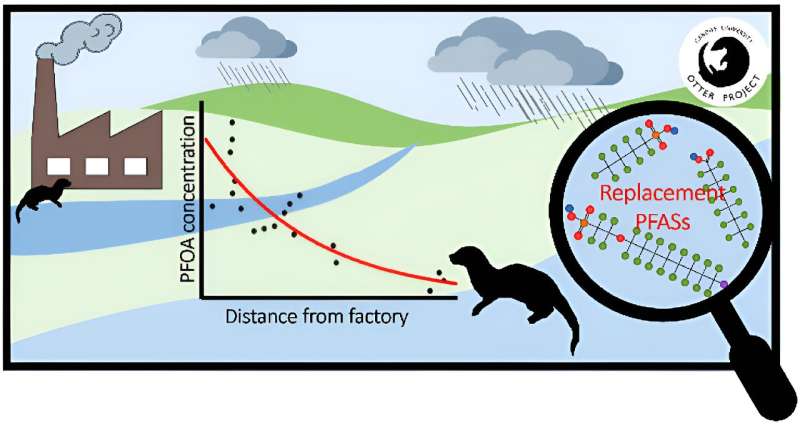This article has been reviewed according to Science X's editorial process and policies. Editors have highlighted the following attributes while ensuring the content's credibility:
fact-checked
peer-reviewed publication
trusted source
proofread
Researchers find 'forever chemicals' in English otters

New research by Cardiff University's Otter Project has found that PFAS, also known as "forever chemicals," present in English otters, raising concerns about potential health impacts in the future.
The Cardiff scientists tested otters from across the UK to monitor levels of PFAS in the environment, to gain an understanding of the concentration of these chemicals in the UK's freshwaters, their persistence in the environment and any ecological and health risks. The researchers were particularly interested in the levels of forever chemicals in otters living near factories that use PFAS in their production.
Emily O'Rourke, Research Associate at Cardiff University School of Biosciences, said, "PFAS or 'forever chemicals' are extensively used in various industries for their water and oil repelling properties.
"PFAS chemicals are highly soluble in water, and often enter the environment via wastewater from industry, as well as run off from sewage, landfill, and PFAS-based firefighting foam. As otters are top predators in British freshwaters, they can accumulate PFAS chemicals through their diet, making them effective indicators of environmental contamination."
The Cardiff University Otter Project is a research initiative focused on studying otters from across the UK. The project uses otters that have been found dead to monitor otter populations and study otter ecology, to help protect British otters. The study expands on their previous research, and examines the concentrations of 33 types of PFAS chemicals in found dead otters from between 2015 to 2019, focusing on an area affected by a factory previously using PFAS chemicals.
"Our previous research using otters revealed high concentrations of a PFAS chemical, PFOA, near a factory using the chemical to manufacture PTFE—commonly known as Teflon. The factory stopped using PFOA in 2012 due to regulations, but our new study shows that PFOA concentrations still remain high near the factory. As PFOA is very persistent in the environment, this is expected to remain for many years, despite ceasing its use.
"Evidence suggests PFOA will gradually migrate through soil to groundwater and thus become less bioavailable, but the timeframe of this is unknown. Biomonitoring of otters in this area provides a valuable way to determine how long industrial activity can impact ecosystems nearby," added O'Rourke.

Some PFAS chemicals—such as PFOS and PFOA—are regulated, because they are toxic and can persistently remain in the environment. Because of this, manufacturers have replaced them with structurally similar compounds. The researchers also investigated the levels of the replacement chemicals present in the UK otter populations.
The study found that while the older, now regulated, PFAS chemicals are still present at highest concentrations in the otters, the newer replacement PFAS chemicals are now also being detected—in fact, some of the replacement compounds were detected in most of the otters.
This included the presence of F-53B, a compound used in the electroplating industry in China. F-53B is not currently used in the UK, but was detected in 19 of the 20 otters analyzed, suggesting it is entering the British environment via the use and disposal of imported products containing F-53B, or via long-range transport from China.
"This finding adds to growing evidence that many replacements are, or have the potential to become, global contaminants. This is especially concerning due to their possible toxicity. Studies on rats, mice, and fish have started to demonstrate that they have the potential to cause toxic effects," added O'Rourke.
"There is concern that some of these replacement PFAS chemicals may be just as persistent and toxic as the compounds they have replaced. Further research is urgently needed on replacement PFAS chemicals in order to establish their risk to apex predators—like otters—and humans," said Dr. Elizabeth Chadwick.
"The increased production, use and emissions of replacement PFAS chemicals will inevitably lead to increased environmental and human exposure. It will take many years for global environmental levels to respond to any regulatory action to reduce emissions if health risks are confirmed in the future. So it's important that we continue to gain a better understanding of its risks and presence in our environments now."
The research, "Persistence of PFOA Pollution at a PTFE Production Site and Occurrence of Replacement PFASs in English Freshwaters Revealed by Sentinel Species, the Eurasian Otter (Lutra lutra)," was published in Environmental Science and Technology.
More information: Emily O'Rourke et al, Persistence of PFOA Pollution at a PTFE Production Site and Occurrence of Replacement PFASs in English Freshwaters Revealed by Sentinel Species, the Eurasian Otter (Lutra lutra), Environmental Science & Technology (2024). DOI: 10.1021/acs.est.3c09405
Journal information: Environmental Science and Technology , Environmental Science & Technology
Provided by Cardiff University

















